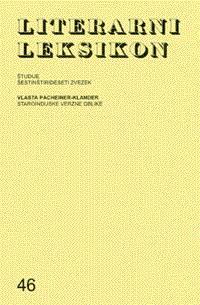Staroindijske verzne oblike
In the introductory chapter, the meaning of both parts of the composite denotation 'ancient Indian' is explained: the origin and the geographical extent of the term 'Indian', and its temporal limitation 'ancient' to the literature in the Old Indian and the Middle Indian languages. The discussion of the terms 'versology', 'metrics' and 'prosody' with their Slovene equivalents and usage follows, as well as of the Indian word 'chandas' in the meaning of 'metre' and 'metrics', and Indian prosodic treatises are briefly mentioned.
In the 2nd chapter, the verse patterns of the poetry in the four Vedas, the earliest collections of ancient Indian poetry from 1500 to 700 B.C., are described. One can notice here the same tendency which later on becomes a rule that a poem is a sequence of stanzas, not of single verse lines. Seven basic forms of stanzas are predominant, numbering 24 to 48 syllables, the number of syllables being the main characteristic of these verse forms. The stanzas consist of three or four verse lines. Four of these forms of stanzas are used more frequently: 'gayatri', 'tristubh', 'jagati' and 'anustubh'. The first three occur in Vedic texts often connected with various symbolic meanings.
The research into Vedic versification centres on two questions: 1) Were the rules regarding the changes at the junction of two adjacent words ('samdhi'), which can lessen the number of syllables, already obligatory, or is there a necessity for the 'syllabic restoration', and 2) Does syllabic Vedic poetry also show any tendency towards a regular quantitative rhythm? The present research 1) is in favour of 'syllabic restoration' and 2) confirms the tendency towards iambic rhythm in parts of the late 'anustubh' and in the starting and closing parts of 'tristubh' and 'jagati' verses, while their middle part, called the 'break', opposes this tendency and, by avoiding the repetition of small rhythmic units, brings them in harmony with the whole of ancient Indian versification.
The 3rd chapter deals with the efforts of European and American scholars to reconstruct Indo-European verse forms on the basis of the similarities between 8-, 11- and 12-syllable verse lines in Avesta, Vedas, Greek poetry and some Slavonic and Old Irish verse forms. The theories in favour of the reconstruction are presented together with the linguistic arguments against them by their critics.
The 4th chapter follows the development of the three verse forms from Vedic times through epic and Pali texts to their classical forms. Thus the Vedic 'anustubh' gradually changes into the epic 'sloka' with a pair of 16-syllable lines, each containing two short typical sequences of long and short syllables. As this is the most important verse form in all Sanskrit versification, some details of its structure are given. Two other less complex verse forms, 'tristubh' and 'jagati', can also be traced from the Vedic period to their classical forms.
In the 5th chapter, classical Sanskrit prosody is dealt with. First the 'moric metres' - 'matrachandas', partly measured by a temporal equivalent for a short syllable, called 'mora' - 'matra', are mentioned. As an early hybrid form in Pali texts they are soon superseded by more flexible 'quantitative metres', - 'ganachandas', arranged into 'feet' - 'ganas' by special rules, taking two short syllables as equivalent to one long syllable. Among them the 'arya' is by far the most frequent.
The most numerous classical verse forms are in the 'metres [with a regular sequence] of [short and long] syllables' - 'aksarachandas'. The number of syllables is determined, as well as the sequence of long and short syllables without the possibility of exchanging two short syllables for a long one, the last syllable of a line being the only one remaining undetermined. Thus the metrical freedom of earlier times is replaced by hundreds of fixed verse forms with a complex metrical structure, but only a few dozen of them are frequently used in classical Sanskrit literature.
The final chapter contains an analysis of metrical translations of ancient Indian metres into European languages with an accentual verse system, including Slovene. The basic models fit into three main types of verse translation, in the theory of translation called ' mimetic' or ' imitative', 'analogical' and 'organic'. The translators of the first type want to imitate the original verse structure, which is almost impossible. The translators of the second type use European verse forms familiar from similar European literary genres. The 'organic' translation takes its own poetic shape regardless of the original and conventional European metres. Very often we also find combinations of these types. Slovene translations are moderately 'imitative' or moderately 'analogical' or a combination of both, as they try to cope with the same problems as other European translations having similar prosody.
Downloads

Series
License

This work is licensed under a Creative Commons Attribution-NonCommercial-NoDerivatives 4.0 International License.
